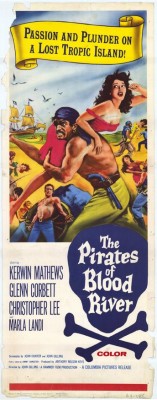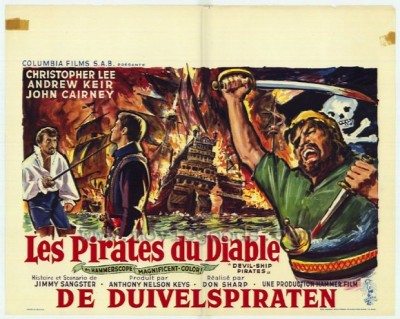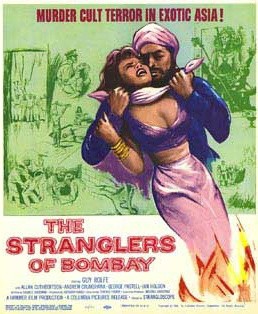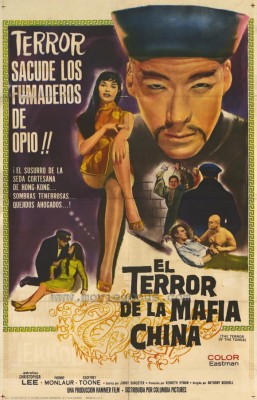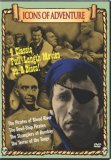| Reviews & Columns |
|
Reviews DVD TV on DVD Blu-ray 4K UHD International DVDs In Theaters Reviews by Studio Video Games Features Collector Series DVDs Easter Egg Database Interviews DVD Talk Radio Feature Articles Columns Anime Talk DVD Savant Horror DVDs The M.O.D. Squad Art House HD Talk Silent DVD
|
DVD Talk Forum |
|
|
| Resources |
|
DVD Price Search Customer Service #'s RCE Info Links |
|
Columns
|
|
|
Icons of Adventure (The Stranglers of Bombay / The Terror of the Tongs / The Pirates of Blood River / The Devil-Ship Pirates)
Of course, the real audience for this set is Hammer fans and perhaps more general genre buffs nostalgic for early '60s Saturday matinee fare. Maybe Sony belatedly realized this, as a sticker on the packaging promises "3 Films Starring Christopher Lee." His image dominates the odd DVD cover design, another indication most of the folks at Sony have no idea how to sell this thing.
Hammer, of course, is best remembered for its Gothic horror films, especially the Dracula and Frankenstein movies starring Lee and Peter Cushing. But the company made pictures of all kinds: comedies, noir, science fiction, war movies, musical shorts. In the early 1960s especially, when horror was just beginning to dominate the company's lineup, executive producer Michael Carreras and others mounted these modest but fun and generally quite successful period thrillers.
Popular as they were, and despite some horrific content and the presence of Hammer regulars like Lee, the four films collected here have generally been out of circulation for years. Their release now is especially welcome.
Except for a couple of brief stock shots and a single matte painting, there are no pirate ships to be found in The Pirates of Blood River, a colorful but badly written swashbuckler. Like the title characters, Hammer almost gets away with murder; the cheap production consists mainly of one vast interior set, the main hall of Huguenot refugees, a sprawling (but inexpensive) village exterior and reasonably convincing, vaguely Caribbean jungle terrain nearby.
After being caught having an elicit affair with the wife of one of the village elders, Jonathon Standing (Kerwin Mathews) is banished to a penal colony by his sanctimonious religious zealot father Jason (Andrew Keir). After months of abuse, Jonathon escapes from prison, only to fall into the hands of pirates led by Captain LaRoche (Christopher Lee), who touts not only the requisite eye patch but also a useless, withered arm. (Lee is also just about the only Frenchman in the film who speaks with a French accent. More on this later.)
LaRoche convinces the unfathomably naïve Jonathon that the pirates will restore democracy (!) to the corrupt village when in fact they're only interested in treasure allegedly hidden there, treasure Jonathon knows does not exist. Upon arrival they threaten to kill two men per day until Jason reveals the treasure's location.
The Pirates of Blood River isn't all that good but so what? What's not to like in such a colorful widescreen swashbuckler pitting filmdom's Sinbad against the screen's foremost Dracula, and featuring Oliver Reed, Peter Arne, and Michael Ripper as lusty, cutthroat pirates? (In his first scene Reed immediately gets into a drunken brawl, beating the hell out of some guy. Art imitating life.) The main problem is that the script makes Mathews' Jonathon the picture's hero by default. The screenplay (by John Hunter and director John Gilling, from Jimmy Sangster's story) suggests an even roguier backstory for the character, but in any case the film is populated by pharisaical and/or corrupt French Calvinists, abusive prison guards, and immoral pirates.
The late Kerwin Mathews delivers an impressive performance despite the weak material. He does a marvelous job expressing confusion, anger, and disappointment at his father's pig-headedness, and is more expectedly terrific in the action scenes, going for broke in scenes as few others did.
About the casting: fellow American Glenn Corbett, another Columbia contract player, plays Jonathon's brother-in-law. Interestingly, each plays their character with their own flat American accents (Mathews grew up in Wisconsin; Corbett was born in El Monte, California); you don't even blink at Mathews' presence, who's totally in his element, but Corbett seems completely out of place, sticking out like a sore thumb. Why that is I have no idea, though I'd be interested in hearing any theories.
Lee is okay in a murkily-defined role. Both the script and Lee try to bring a slightly tragic and sympathetic air to the character, a man more intelligent and refined than the rest of his brood, but he's also a liar, merciless, and generally unlikable. There seems to have been some attempt to draw parallels between Lee's and Keir's similar characters, though this is slight and easily overlooked.
A couple of scenes appear written to remind audiences that this is, after all, a Hammer film. The picture is book-ended with what for the time were pretty gruesome death-by-piranha scenes, its victims screaming and swallowed up in a pool of their own blood. There are also endless murders and threats of rape, underscoring the hypocrisy of the British Board of Film Censors in awarding this a "U" certificate (the equivalent of a "G" rating in America) while Hammer Horrors with an equal amount or even less violence were constantly rated "X" or ordered cut. The Pirates of Blood River, meanwhile, went out on the children's matinee circuit, on a double-bill with the Ray Harryhausen Mysterious Island. (***)
Much superior is The Devil-Ship Pirates; Jimmy Sangster's screenplay is pretty clever while keeping the story within budgetary constraints - it doesn't attempt more than its budget would allow. When the Diablo (that's Spanish for "Devil," in case you missed it), a ship manned by privateers commissioned into the Spanish Armada, is damaged and separated from the fleet during battle with Britain, Captain Robeles (Christopher Lee) makes a desperate decision. He deliberately grounds her in shallow water off the remote Cornish coast, hoping to make repairs before the next tide.
When two scouts are discovered in the nearby village, the only one within many miles of the Diablo, first mate Manuel (Barry Warren) comes up with an ingenious ruse: casually strolling onto the scene, he convinces the townsfolk that the Armada was successful, that Spain has conquered Britain. As the spineless local squire (Ernest Clark) kowtows to his "conquerors," Manuel learns Robeles has no intention of returning to the Spain, but instead plans to resume his pirating activities in the West Indies.
Beyond Sangster's script, which keeps the action confined to the Diablo, the village, and the bog-filled terrain in between, Devil-Ship Pirates benefits mainly from Don Sharp's dynamic direction. His striking Megascope compositions, with DP Michael Reed, make full use of the widescreen frame and keep things interesting. Like Hammer's in-house art director Bernard Robinson, Sharp (Kiss of the Vampire) had a great talent for making his films look far more expensive than they actually were; one need only compare Sharp's Fu Manchu entries to Jess Franco's threadbare ones for evidence of this.
Hammer sprang for a small but full-size pirate ship, built at a cost of 17,000 pounds (about $47,600 - hey, that's cheap!) and even an (unconvincing) miniature of the Diablo for a few shots. (Other miniature battle footage seems culled from another movie.) Early scenes on deck and of the Diablo miniature are deliberately foggy and filtered, partly to lend some atmosphere but mainly to hide construction of the M4 motorway just beyond the set.
As with The Pirates of Blood River, many of the Spanish pirates have Cockney accents: Michael Ripper (as, ahem, "Pepe"), lusting after a young maiden, actually exclaims "Allo! Allo! Allo!" Lee's Robeles is a more conventional villain, a throwback to the kind of parts Basil Rathbone used to play opposite Errol Flynn and Tyrone Power, but does so with his usual engaging relish. Near the end of the film, in a climatic duel, Lee claimed he got so close to some flames his wig caught on fire and the film bears this out. (****)
The most sought-after film in this collection, The Stranglers of Bombay was notorious for its (by 1960 standards) extreme violence. Though much more implied than actually shown - it's mild, for instance, compared to Nobuo Nakagawa's Jigoku, released that same year - removed from Hammer's usual world of Gothic fantasy and into one purporting at least to be a historically accurate account of India's Thuggee cult, contemporary audiences were left shell-shocked and appalled. Incredibly, the film was originally rated "A" in Britain rather than the expected "X," in yet another example of the Board's prejudice against Hammer's horror films.
In 1820s India, the all-powerful East India Trading Company and its auxiliary military contingent are besieged by caravan robberies and unsolved mass kidnappings. Captain Lewis (Guy Rolfe, Mr. Sardonicus) has been amassing evidence pointing to a religious cult but his superior officer, Colonel Henderson (Andrew Cruickshank), instead appoints an old school friend, self-involved racist Captain Connaught-Smith (Allan Cuthbertson), a man completely ignorant of Indian culture, to lead the investigation.
With Connaught-Smith smugly dismissing Lewis' years of research, as well as new evidence that the Thuggees plan to raid a massive caravan, a frustrated Lewis resigns his commission but continues to investigate the murderous worshippers of Kali.
Is Stranglers of Bombay racist? An expression of nostalgic, lingering British Imperialism? Personally, I don't think there are much intended or unintentional historical/cultural/religious implications in the film, any more than B-Westerns that pit cowboys against American Indians, or Tarzan movies with the King of the Jungle battling African savages. My pal DVD Savant has noted that the historical Thugs, rather than an al-Qaeda type organization of religious radicals dedicated, as in the film, to driving infidels from India, in fact were basically little more than highly successful thieves. In both the film and in historical fact they were secretive and notorious. Very little is known of the Thuggee even today; some say the cult murdered up to two million people while other researchers put the figure at closer to 50,000. Still others question the very existence of the cult at all, suggesting it sprang from the racist imaginations of British colonialists and perpetuated by the East India Trading Company.
In any case, the film is a catalog of gruesomeness. The Thuggees cut the tongues and eyes out of their prisoners - the lone female of the cult sadistically enjoys taunting the helpless men with ladlefuls of water - before asphyxiating them with their trademark strangling silks. Stomachs are slit (so their bodies won't bloat after death) hands are dismembered, and by the end of the film bodies are everywhere, like the last act of Hamlet. Best of all is a one-of-a-kind shock: a disgraced Thuggee, convinced death will bring him closer to Kali, literally jumps into a hangman's noose.
Though Hammer went to the trouble of hiring New Yorker David Zelag Goodman to write what for the time was considered an historically accurate screenplay (Goodman's other credits include the film adaptations of Lovers and Other Strangers, Straw Dogs, and Farewell, My Lovely), some of which was altered or cut before filming having been deemed even more grisly than what made it into the final cut, The Stranglers of Bombay can't shake its exploitative air. It's a cheap film designed - and, in its defense, very effectively realized - to deliver thrilling, action-filled entertainment.
6'4" Guy Rolfe seems to have been cast for no other reason than his vague resemblance to both Christopher Lee and Peter Cushing. Unfortunately, Rolfe has none of Lee's charisma (roughly the same height, Lee is commanding while Rolfe looks like a scarecrow) nor Cushing's acting chops. Though I wouldn't accuse Rolfe of walking through the role, in two-shots he frequently seems to be looking off-camera, over the actors' heads as if reading lines off cue cards. The prolific Cuthbertson comes off better as the blithely snobbish Connaught-Smith, a real SOB, while George Pastell (as the High Priest of Kali), Marne Maitland (as Patel Shari), Paul Stassino (Lt. Silver), and an unbilled Roger Delgado (as Bundar) sink their teeth into Thuggee roles.
Terence Fisher directed; he and composer James Bernard do a fine job maximizing the shocks, and know when not to use underscoring. One of the film's best scenes has Lewis' wife (Jan Holden) unwrapping what turns out to be the severed hand of their Indian manservant. There's no music, nor does she scream in reaction to the grisly sight, which in turn heightens the effect. (****)
Something of a follow-up to Stranglers of Bombay, The Terror of the Tongs similarly follows a British man's investigation of a secret society of criminals terrorizing a good swath of Asia, in this case the Hong Kong branch of The Red Dragon Tong. Christopher Lee gets top-billing for the first time in a Hammer film as Chung King, its Fu Manchu-like leader.
Ming (Burt Kwouk, later Cato in the Pink Panther movies), fearing for his life, hides a list of Tong members in a book presented to Helena (Barbara Brown), the daughter of ship's Captain Jackson (Geoffrey Toone). Jackson is helpless when Ming is brazenly murdered by Tong assassins on the dock adjacent to his ship. Later, when Chung King determines the list must be in Jackson's possession, Tong gangsters steal the book and brutally murder 16-year-old Helena.
Determined to track down Helena's killer, Jackson rather foolishly begins asking questions, but an underground anti-Tong movement led by an unnamed beggar (Marne Maitland again) opt to take advantage of Jackson's reckless investigation to get at the Tong.
Taking advantage of Hong Kong dock sets built for an unsold television pilot (Visa to Canton/Passport to China, eventually released as a feature), The Terror of the Tongs is another example of Grand Guignol Exotica from Hammer, this one featuring hatchet murders (the working title was "Terror of the Hatchet Men") and dismemberment, slavery, drug use and, most infamously, a "bone-scraping" torture scene, with "Guardian" (so billed in the credits), played by Hammer's answer to Tor Johnson, Milton Reid, pokes long needles into Jackson's bared chest.
Perhaps the most striking thing about The Terror of the Tongs is the dearth of Asian actors. Except for Kwouk, nearly every speaking part is played by a non-Asian in unconvincing eye makeup. (Some, like Lee, have eyelid prosthetics while others make do with mascara and jutting eyebrows.) An actor like Lee could get away with such parts by sheer force of personality alone, but it's something else again to see good actors like Charles Lloyd Pack struggling to convince us they're Asian. Most ridiculous of all is Yvonne Monlaur (Circus of Horrors, Brides of Dracula) as Chinese ingénue Lee; a black wig and tight silk dress can't hide that thick French accent.
Of course, no one went to see The Terror of the Tongs expecting historical and racial authenticity, so to complain about such things is beside the point. Indeed, it's better to just sit back and enjoy the occasional ludicrousness of some scenes, like Chung King's gambling den, where the entertainment includes a juggler performing next to a shapely "Chinese" dancer wearing an anachronistic bikini. (Like anyone's looking at the juggler!)
Though the film very much plays as a warm-up to the Harry Alan Towers-produced Fu Manchu movies, to his credit Christopher Lee's Chung King is subtly different from his later interpretation of Sax Rohmer's infamous yellow devil. Lee's Chung King is more animated, less inscrutable. Supposedly the Bond producers looked at this when they were casting the title character in Dr. No (1962); ironically while Joseph Wiseman's Bond villain owed a lot to Fu Manchu, Lee's Chung King is more the intellectual criminal mastermind along the lines of Ian Fleming's Ernst Blofeld.
Jimmy Sangster's script delivers plenty of action and very little subtlety. An example of short-cut exposition: When Tong lackey Tang How (Ewen Solon) corners Jackson with a revolver, he smugly tells the Brit, "No harm can come of it now, so I will tell you what I do for the Tong...." Tang then makes like a CFO at a stockholder's meeting, telling Jackson exactly what he wants to know about the Tong's opium smuggling.
Toone's Jackson is uncharismatic and actor-turned-director Anthony Bushell's direction is somewhat flat, but as with The Stranglers of Bombay James Bernard's score is evocative and exciting, and like the rest of the films in this set bears Hammer's unmistakable stamp of modest-budget polish all around. (*** 1/2)
Video & Audio
All four features are given excellent 16:9 enhanced transfers. The Stranglers of Bombay, The Pirates of Blood River, and The Devil-Ship Pirates were all "Hammerscope" Productions, filmed in the CinemaScope-compatible Megascope. (Megascope was apparently a Hammer-owned trademark interchangeable with Hammerscope in both the credits and billing. Some ads billed Stranglers of Bombay as being in "Strangloscope!")
The Stranglers of Bombay is in black and white and though a tad soft at times, this seems inherent with the original release and not the fault of the transfer. (Hammer's black & white/'scope production of The Abominable Snowman has similar issues.) The two pirate films were processed by Technicolor in the United Kingdom but for its U.S. release Columbia used inferior Eastman Color on Blood River and "Eastman Color by Pathé" for Devil-Ship Pirates, presumably Eastman as a source and Pathé for theatrical prints. In any case, happily the color on these films is excellent with no signs of fading or computer tweaking.
The Terror of the Tongs, shot for 1.66:1 cropping and presented at about 1.70:1 here, reportedly was originally released in the United States in black and white, but what's presented here is in full color, again billed in the credits as "Eastman Color by Pathé." Once again the color looks just great as does the transfer, and there are none of the kind of cropping issues that marred Warner Home Video's early Hammer releases, The Curse of Frankenstein and Horror of Dracula.
Though all are mono releases, the fidelity in these Dolby Digital mixes are exceptionally good; all offer optional English and French subtitles, and all but Stranglers include French audio ("Bonjour! Bonjour! Bonjour!").
Extra Features
Marcus Hearn (co-author, with Alan Banes, of the highly recommended The Hammer Story) moderates commentaries included on all four features, at various times featuring writers Jimmy Sangster and David Z. Goodman, longtime Hammer editor Chris Barnes and art director Don Mingaye. Discussions aren't limited to the films at hand but Hammer generally, and Hearn does a fine job keeping the discussions on-track.
The Merry Mutineers (1936) is a charming and rarely-shown Columbia-produced "Scrappy" cartoon in Technicolor, featuring caricatures of Hollywood stars (Charles Laughton as Captain Bligh, Wallace Berry as Long John Silver, etc.) as pirates and British sailors. For maybe the only time, cartoon versions of Laurel & Hardy, the Three Stooges, and The Marx Bros. all appear together; ironically the Stooges, under contract to the studio, come off worst while Laurel & Hardy and the Marx Bros. are both well-drawn and animated.
Hot Paprika (1935) is a Columbia two-reeler starring Scottish-born comedian Andy Clyde, who made shorts during the same time as the Three Stooges and was equally well-known as Hopalong Cassidy's middle- and late-period sidekick, California Carlson. The short, directed by the underrated Preston Black (actually Jack White, department head Jules' brother), is quite funny: Trying to cure Andy's hiccups, Dr. Bud Jamison scares him into thinking he has just a few months to live. Deciding to live it up, Andy heads for the Latin American country of Paprika, unaware that he's being manipulated into serving as a catalyst for a revolution.
Chapter One of the 1953 Columbia serial The Great Adventures of Captain Kidd is included. Unlike the mechanical hum-drum sample chapter of Mysterious Island (1951) that accompanied Sony's Sam Katzman Collection, Captain Kidd's first chapter is a lot of fun. Except for Westerns, serials with period settings were rare; I'm not aware of any other swashbuckler chapter-plays. Of course, this being one of the last of a dying breed, Captain Kidd heavily mines Columbia's stock footage library: virtually every miniature pirate ship and matte-painted establishing shot is lifted from some other movie. The decks of the ships in the footage are seen in cramped medium shots to minimize construction costs. Though cheap, this one really moves. Richard Crane, Rocky Jones (Space R-r-r-r-anger!) stars.
Incidentally, while it's nice that labels like VCI are releasing public domain versions of many of these Columbia serials, especially since Sony appears loathe to do so themselves, the clarity of the image (if not the hissiness of the audio) really makes one wish Sony would get more of these out. Serial fans are a small but dedicated bunch; I'd like to see the rest of The Great Adventures of Captain Kidd.
Original trailers, all 16:9 enhanced and complete with text and narration, are also included.
Parting Thoughts
Though Icons of Adventure isn't likely to appeal much to as wide an audience as perhaps Sony would like, it's also got a not-insignificant core audience that can't wait to see it, and for them the wait will be more than worth it. The films look great and the extras and terrific. Presently via its Columbia library Sony is sitting on more than a dozen Hammer titles it has yet to release in any home video format. Though a DVD of something even as dreadful as Daddy Day Camp likely will outsell this 50 times over, one hopes the label will recognize that there's money to be made in the two dozen or so Sony-owned Hammer titles that mostly have been gathering dust in Sony's vaults these past 40-50 years. Don't hold your breath, but here's hoping Icons does well enough to warrant the release of some other long-lost Hammer films, including The Camp on Blood Island, Yesterday's Enemy, Never Take Sweets from a Stranger, Sword of Sherwood Forest, Cash on Demand, The Damned, The Old Dark House, Maniac, and The Scarlet Blade. In the meantime, Icons of Adventure is Highly Recommended.
Film historian Stuart Galbraith IV's latest books, Japanese Cinema and The Toho Studios Story, are now available for pre-order.
|
| Popular Reviews |
| Sponsored Links |
|
|
| Sponsored Links |
|
|
| Release List | Reviews | Shop | Newsletter | Forum | DVD Giveaways | Blu-Ray | Advertise |
|
Copyright 2024 DVDTalk.com All Rights Reserved. Legal Info, Privacy Policy, Terms of Use,
Manage Preferences,
Your Privacy Choices | |||||||









